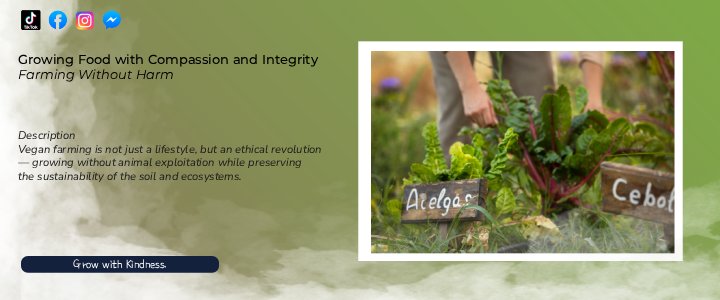Vegan-Organic Farming
Vegan-organic farming is reshaping the way we grow food—combining the ethics of veganism with the sustainability of organic agriculture. Instead of relying on animal by-products like manure or bone meal, this farming method focuses on plant-based compost, crop rotation, and soil health. In temperate climates, where seasons shift between cool and warm, choosing the right crops is essential for both productivity and sustainability.
Below, we’ll explore the best crops for vegan-organic farming, focusing on plants that thrive naturally in moderate conditions and support long-term soil fertility.
Understanding Vegan-Organic Farming
Vegan-organic farming (also called “veganic farming”) aims to grow food without exploiting animals or using animal-derived fertilizers. Instead, farmers build soil fertility through green manures, composted plant materials, and cover crops.
Key Principles of Vegan-Organic Farming
- No animal inputs: Avoid manure, fish emulsion, or blood meal.
- Focus on soil health: Use composted plants, mulch, and nitrogen-fixing crops.
- Encourage biodiversity: Attract pollinators and beneficial insects naturally.
- Promote self-sufficiency: Use locally sourced seeds and organic materials.
This approach not only supports ethical agriculture but also enhances soil sustainability and reduces environmental impact.
Best Crops for Temperate Vegan-Organic Farms
Temperate climates—like those found in parts of North America, Europe, and East Asia—offer balanced conditions with mild summers and cool winters. These regions are ideal for growing diverse vegan-organic crops.
| Crop Type | Examples | Vegan-Organic Benefits |
|---|---|---|
| Legumes | Peas, beans, lentils, chickpeas | Fix nitrogen in soil naturally and provide plant-based protein |
| Leafy Greens | Spinach, kale, lettuce, Swiss chard | Fast-growing, high in nutrients, great for soil rotation |
| Root Vegetables | Carrots, beets, radishes, turnips | Help break up soil and improve aeration |
| Grains | Oats, barley, rye, quinoa | Provide carbohydrates and organic matter for compost |
| Brassicas | Broccoli, cabbage, cauliflower | Cold-tolerant and ideal for winter or early spring planting |
| Fruits | Strawberries, apples, pears, blueberries | Support pollinator activity and long-term sustainability |
Legumes: The Foundation of Sustainable Farming
Legumes are among the most valuable crops for vegan-organic farming. Through nitrogen fixation, they naturally enrich the soil—eliminating the need for chemical fertilizers or animal manure. Varieties such as fava beans, lentils, and clover not only boost soil fertility but also serve as nutritious food sources.
Practical Planting Tips:
- Rotate legumes with cereals or greens to maintain balanced soil nutrients.
- Use crop residues as compost or green mulch.
- Choose locally adapted varieties for better yield.
Leafy Greens and Root Crops: Nutrient Powerhouses
Leafy greens like spinach and kale are ideal for quick harvest cycles and continuous production. They grow well in cool seasons, making them perfect for temperate climates.
Meanwhile, root vegetables such as carrots, radishes, and beets loosen the soil and enhance drainage. Together, they form a powerful combination for soil structure and nutritional diversity.
Grains and Cereals: Long-Term Sustainability
Grains play an important role in vegan-organic farming systems. Crops like oats, barley, and rye thrive in moderate climates and can be used as both food and soil cover. These grains prevent erosion, build organic matter, and offer a renewable source of mulch or compost base.
Recommended Practices:
- Rotate grains with legumes to restore nitrogen balance.
- Use straw residues as organic mulch.
- Avoid overharvesting to maintain soil protection year-round.
Fruits and Perennials: Building Biodiversity
Incorporating fruit-bearing plants and perennials adds stability to your farming system. Apples, blueberries, and strawberries attract pollinators, support biodiversity, and offer consistent yields across seasons. These crops also improve the resilience of the farming ecosystem by maintaining long-term soil cover.
Creating a Balanced Vegan-Organic Crop Plan
A successful vegan-organic farm depends on strategic planning. Combine fast-growing crops (like greens and radishes) with slow-maturing ones (like grains or fruit trees). This not only ensures year-round productivity but also keeps soil ecosystems balanced.
Example Crop Rotation Plan (Temperate Climate)
| Season | Suggested Crops | Purpose |
|---|---|---|
| Spring | Peas, lettuce, radish | Soil enrichment and early harvest |
| Summer | Beans, kale, carrots | Mid-season nutrition |
| Autumn | Barley, spinach | Soil cover and organic matter buildup |
| Winter | Clover, rye | Nitrogen fixing and soil protection |
Vegan-organic farming in temperate climates offers an ethical and sustainable path to food production. By focusing on plant-based soil enrichment, biodiversity, and crop rotation, farmers can achieve high yields without relying on animal inputs or synthetic fertilizers.
Start small, experiment with diverse crops, and observe how your soil and ecosystem respond. Every seed you plant contributes to a greener, kinder, and more sustainable future.



